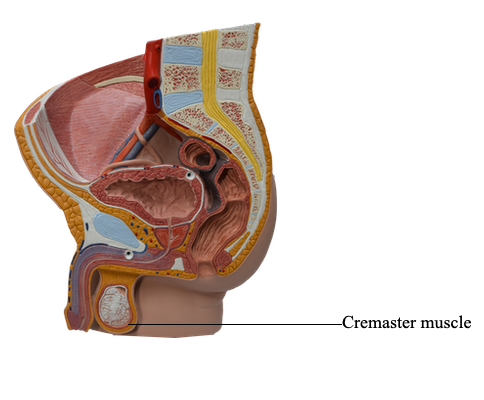Main Model

Cremaster muscle

Spermatic Cord
The spermatic cord contains structures running to and from the testis and suspends the testis in the scrotum. The spermatic cord begins at the deep inguinal ring lateral to the inferior epigastric vessels, passes through the inguinal canal, exits at the superficial inguinal ring, and ends in the scrotum at the posterior border of the testis. Fascial coverings derived from the anterolateral abdominal wall during prenatal development surround the spermatic cord.
The coverings of the spermatic cord include the following:
• Internal spermatic fascia: derived from the transversalis fascia.
• Cremasteric fascia: derived from the investing fascia of both the superficial and deep surfaces of the internal oblique muscle.
• External spermatic fascia: derived from the external oblique aponeurosis and its investing fascia.
The cremasteric fascia contains loops of cremaster muscle, which is formed by the lowermost fascicles of the internal oblique muscle arising from the inguinal ligament. The cremaster muscle reflexively draws the testis superiorly in the scrotum, particularly in response to cold. In a warm environment, such as a hot bath, the cremaster relaxes and the testis descends deeply in the scrotum. Both responses occur in an attempt to regulate the temperature of the testis for spermatogenesis (formation of sperms), which requires a constant temperature approximately one degree cooler than core temperature, or during sexual activity as a protective response. The cremaster typically acts coincidentally with the dartos muscle, smooth muscle of the fat-free subcutaneous tissue of the scrotum (dartos fascia), which inserts into the skin, assisting testicular elevation as it produces contraction of the skin of the scrotum in response to the same stimuli. The cremaster muscle is innervated by the genital branch of the genitofemoral nerve (L1, L2), a derivative of the lumbar plexus. The cremaster is striated muscle receiving somatic innervation, whereas the dartos is smooth muscle receiving autonomic innervation. Although less well developed and usually indistinct, the round ligament of the female receives similar contributions from the layers of the abdominal wall as it traverses the inguinal canal.
The constituents of the spermatic cord are the following:
• Ductus deferens (vas deferens): a muscular tube approximately 45 cm long that conveys sperms from the epididymis to the ejaculatory duct.
• Testicular artery: arising from the aorta and supplying the testis and epididymis.
• Artery of ductus deferens: arising from the inferior vesical artery.
• Cremasteric artery: arising from the inferior epigastric artery.
• Pampiniform venous plexus: a network formed by upto 12 veins that converge superiorly as right or left testicular veins.
• Sympathetic nerve fibers on arteries and sympathetic and parasympathetic nerve fibers on the ductus deferens.
• Genital branch of the genitofemoral nerve: supplying the cremaster muscle.
• Lymphatic vessels: draining the testis and closely associated structures and passing to the lumbar lymph nodes.
• Vestige of processus vaginalis: may be seen as a fibrous thread in the anterior part of the spermatic cord extending between the abdominal peritoneum and the tunica vaginalis; it may not be detectable.
Because it is not a homolog of the spermatic cord, the round ligament does not contain comparable structures. It includes only vestiges of the lower part of the ovarian gubernaculum and the processus vaginalis.